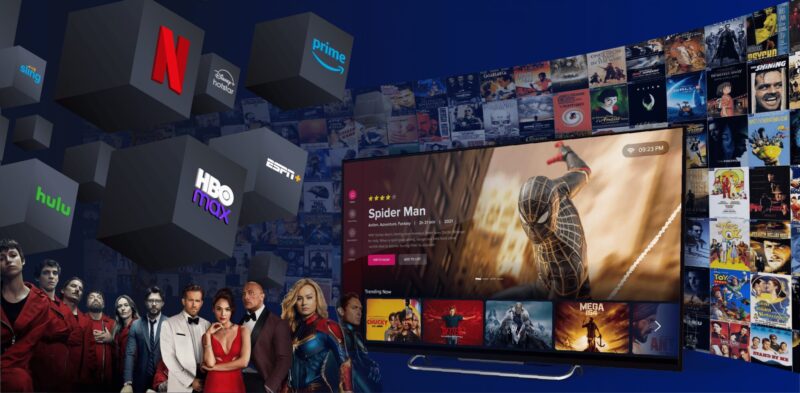An OTT (Over-The-Top) platform business model refers to the approach used by companies that provide online access to video content, such as movies, TV shows, and exclusive series. These platforms have revolutionized how people consume media by giving them more flexibility and control over their viewing experience. By cutting out traditional distribution channels, OTT platforms allow consumers to access content directly on their devices through apps or websites. The revenue streams for these platforms primarily come from pay-per-view, subscriptions, membership fees, and advertising, making them adaptable to different audience needs.
The Rise of OTT Platforms
OTT platforms started gaining momentum in the mid-2000s, with early pioneers like Prime Video, Netflix, and Hulu leading the charge. Launched around 2007-2008, these platforms allowed users to stream content directly to their smart TVs, smartphones, or tablets. This model quickly became popular due to its simplicity, convenience, and accessibility. Gone are the days when people were bound to scheduled TV programming. With OTT, consumers can watch their favorite shows whenever they want, wherever they want, without being tethered to a traditional TV setup.
The appeal of OTT platforms lies in their ability to offer both exclusive and on-demand content. These services integrate seamlessly into the daily lives of their subscribers, providing personalized experiences through branded applications.
Key Components of the OTT Platform Business Model
The OTT business model fundamentally changes the traditional relationship between content creators and consumers. It enables a direct connection between them, removing the need for third-party distributors like cable networks or satellite providers. This direct connection offers several benefits to OTT platforms, including:
- Viewer demographics: OTT platforms gather detailed information about their users, including age, gender, and location. This data helps platforms optimize their content offerings and marketing strategies.
- Content consumption patterns: By understanding what users are watching and when, OTT platforms can create personalized recommendations that improve the user experience.
- Content discovery techniques: Platforms can analyze user behavior to develop algorithms that make it easier for users to find relevant content.
- Device and platform usage: OTT platforms can track which devices their content is being consumed on (smartphones, tablets, etc.) to tailor their services for better user experience.
- Technical performance metrics: Platforms can monitor streaming quality, buffering issues, and overall performance to ensure smooth delivery of content.
These insights are crucial for OTT platforms as they continue to innovate and enhance their offerings.
How OTT Platforms Generate Revenue
OTT platforms have multiple ways to monetize their content. Here are the most common methods:
Direct Advertising
One of the most effective monetization strategies is direct advertising, where platforms have control over the type and frequency of ads shown. This model allows OTT platforms to generate revenue by selling ad slots to advertisers. These ads can appear in various forms:
- Pre-roll ads: These ads play before the actual content begins.
- Mid-roll ads: These are inserted in the middle of a video.
- Banner ads: These are displayed on the platform’s interface, such as on websites or apps.
What makes OTT advertising unique is its precise targeting ability. Based on viewing habits, geographic location, and demographic data, OTT platforms can offer advertisers highly targeted ad placements. This results in a more personalized ad experience for users and higher conversion rates for advertisers. Additionally, platforms can track the performance of ads in real-time, enabling advertisers to adjust their campaigns for better results.
Video Ad Networks (VAN)
Integrating a video ad network (VAN) into an OTT platform is another way to quickly start earning revenue. VANs connect OTT platforms with advertisers who are eager to showcase their ads. By working with these networks, OTT platforms can focus on content creation while leaving ad placement to the VAN, ensuring a steady stream of revenue.
Catch-Up TV
This model allows users to download their favorite shows and watch them later, providing complete flexibility in how and when content is consumed. Platforms adopting this model often charge users for access to premium content, or they may use ads to monetize the viewing experience.
Freemium Model
The freemium business model offers users free access to basic content while reserving premium content for paying subscribers. This approach attracts a larger audience, who can then be encouraged to upgrade for additional features or exclusive shows. Users can make a one-time purchase or subscribe for ongoing access.
Sponsorship Offers
OTT platforms also generate revenue through sponsorship deals, where advertisers sponsor specific content. This works similarly to traditional TV sponsorships, where a brand supports a particular show or event in exchange for promotional benefits. These sponsorships often result in lucrative deals for OTT platforms and allow advertisers to reach a targeted audience.
Diverse Monetization Models
OTT platforms offer a variety of monetization models that cater to different industries and audience preferences. Some common models include:
- AVOD (Advertising Video on Demand): Users can access content for free, but they are required to watch ads.
- TVOD (Transactional Video on Demand): Users pay for individual pieces of content, such as renting or purchasing a movie.
- SVOD (Subscription Video on Demand): Users pay a recurring fee (monthly or annually) for unlimited access to content.
In addition to these, OTT platforms can adopt a hybrid model that combines two or more monetization strategies. For example, a platform may offer both a subscription service and transactional content for special releases.
Popular OTT Revenue Models
OTT platforms have multiple revenue models that allow them to cater to a diverse audience. The most popular ones include:
- Subscription-based: Users pay a regular fee for unlimited access to content, as seen in Netflix and Amazon Prime.
- Advertising-supported: Users can access content for free, but ads are displayed at various points, as seen in YouTube.
- Transactional (Pay-per-view): Users pay to access specific content, which is common for special events like sports or movie releases.
- Freemium: Basic content is free, but premium content requires a subscription or one-time payment.
- Sponsorship and partnerships: Brands collaborate with OTT platforms to sponsor content, helping both parties reach a wider audience.
- Licensing and syndication: OTT platforms may license their content to other services or partners, creating another revenue stream.
Leading Global OTT Platforms and Their Business Models
Several global OTT platforms have adopted different business strategies to stay competitive. Some examples include:
- YouTube: This platform allows users worldwide to upload and watch videos for free. It relies heavily on an ad-supported model but also offers a premium subscription service.
- Prime Video: Amazon’s OTT service offers unlimited streaming of movies and TV shows as part of its Amazon Prime membership. It uses a subscription model combined with transactional content.
- Netflix: Known for its exclusive original content, Netflix operates purely on a subscription model (SVOD), with no ads or pay-per-view options.
Other notable OTT platforms like Hulu, Disney+, and Hotstar also use a mix of these monetization models, including AVOD, SVOD, and TVOD.
Conclusion
The OTT platform business model is constantly evolving to meet consumer preferences and industry trends. With multiple revenue strategies such as subscriptions, advertising, transactional payments, freemium offerings, sponsorships, and licensing, OTT platforms have found various ways to generate income. By diversifying their revenue streams, these platforms can provide a wide range of content options while staying competitive in the ever-changing world of digital media. As OTT platforms continue to adapt, their ability to offer direct access to consumers and provide personalized viewing experiences will keep them at the forefront of the entertainment industry.
















